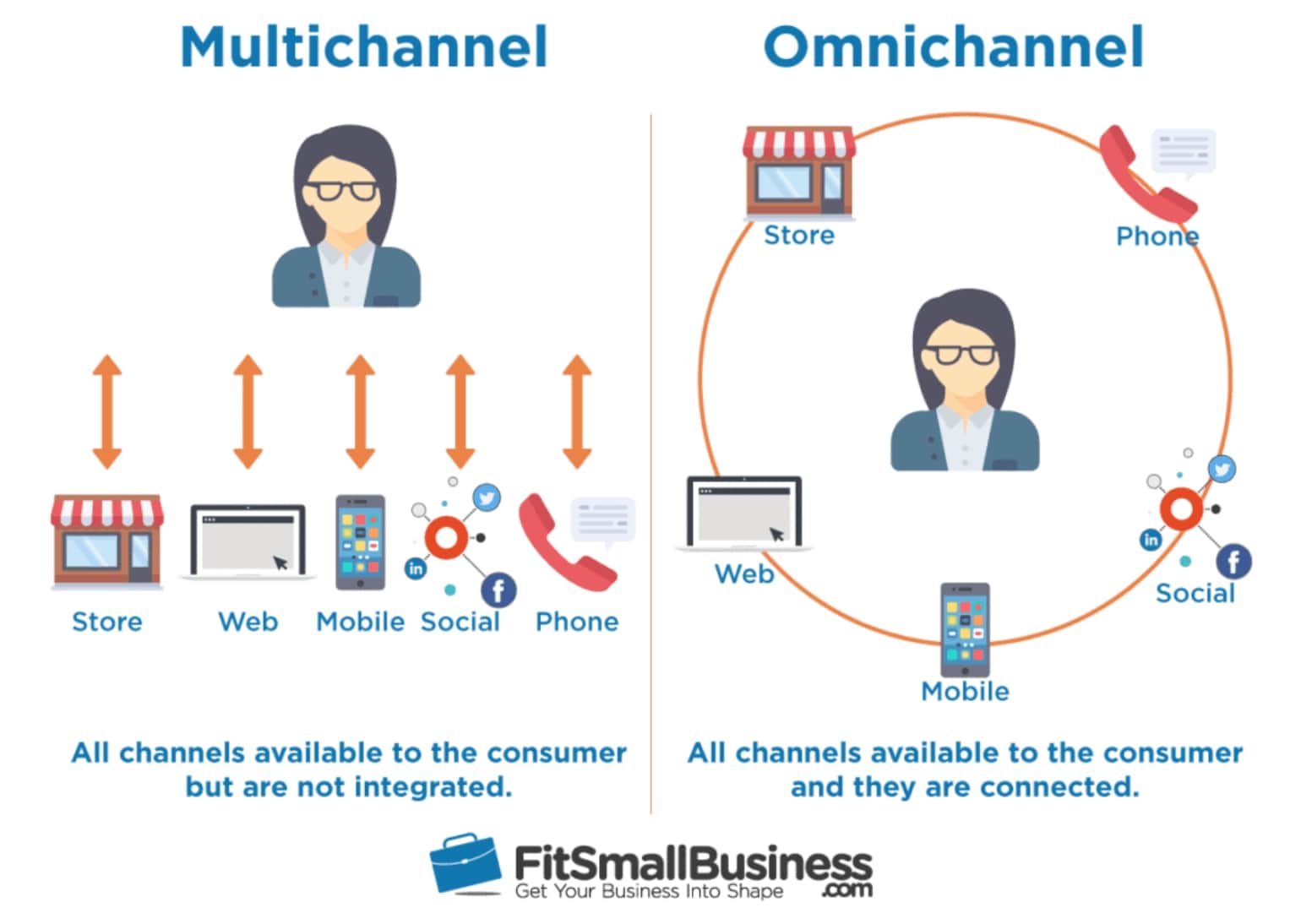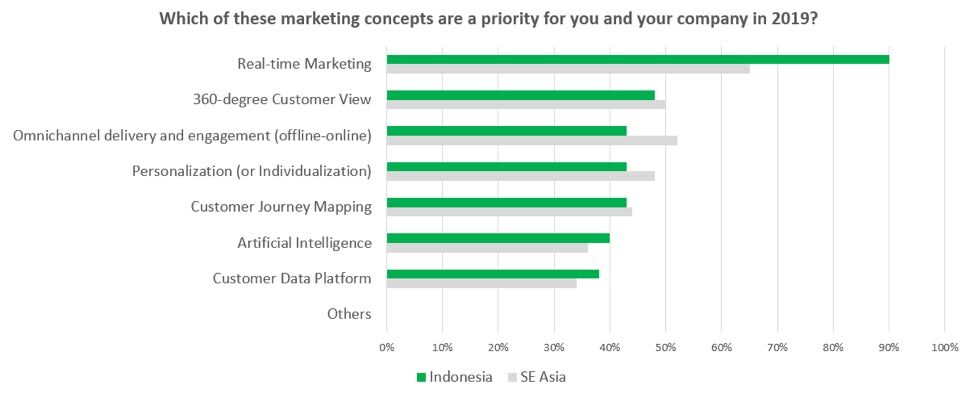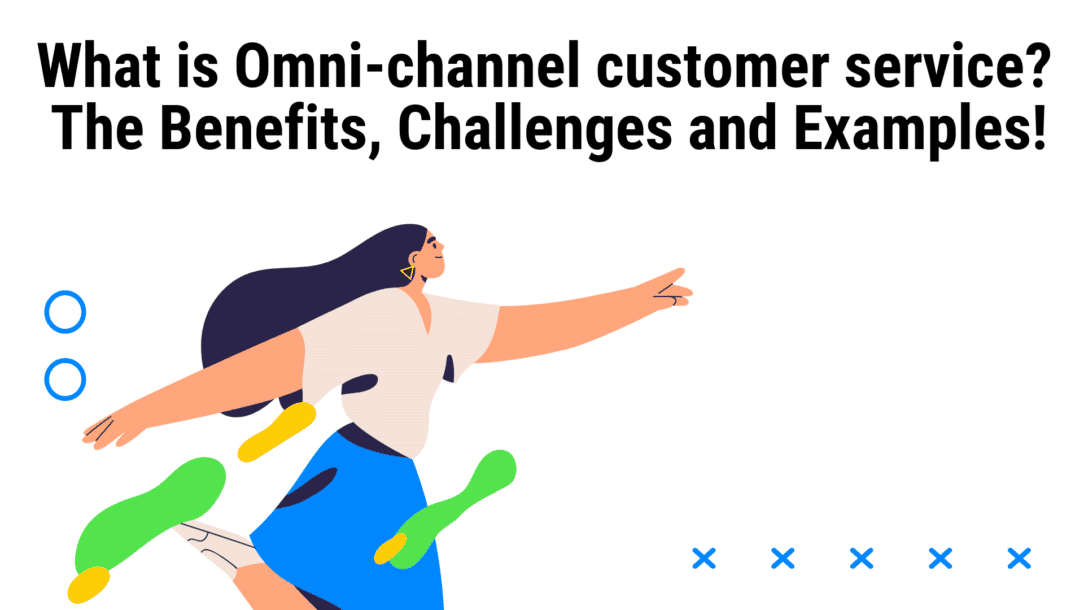Imagine that you are a customer who just purchased from your favorite online store. A few days after receiving your purchase, you find that one of the items is defective. You contact customer service to resolve the issue, but you are told that the item can only be returned in-store. Frustrated, you try to return the item through the mail, but your package is rejected. If only this was a company with Omni-channel support.
What would you do?
If you are like most consumers, you would likely give up and take your business elsewhere. This causes a company to lose a customer: the inability to provide a consistent, convenient, and effortless experience across all channels. Since AI has taken over, companies are offering more channels to interact with the customer. Facebook Messenger, WhatsApp, chatbots, phone calls, in-app messaging, and email are all popular channels that businesses use to communicate with their customers.
That’s what matters in 2022 and beyond. This year, businesses will need to focus on providing an exceptional customer service experience across all channels in order to stay ahead of the competition. So, in this article, we’re going to talk about the following:
- What is Omnichannel Customer Service?
- Difference Between Multi-channel vs. Omnichannel Customer Service
- The Benefits of Omnichannel Customer Service
- The Challenges of Omnichannel Customer Service
- Omnichannel Customer Service Examples
Let’s get started!
What is Omnichannel Customer Service?
Omnichannel customer service is the practice of providing a consistent and integrated customer service experience across all channels. This means that businesses need to provide a seamless experience for customers, whether they are interacting with the company through phone calls, chatbots, social media, or in-person. The goal of omnichannel customer service is to create a cohesive customer service strategy that meets the needs of today’s consumers.
According to the latest insights, businesses can retain 89% of their customers if they provide an omnichannel customer service experience. This is because providing a consistent experience across all channels builds trust and loyalty among customers. In short, it’s about giving customers what they want, when they want it, and how they want it.
Omni Channel vs. Multi-Channel Customer Service
Now that we know what is omnichannel customer service. Let’s take a look at the difference between multichannel and omnichannel customer service. Multi-channel customer service provides customer service through multiple channels, such as phone calls, email, chatbots, and social media. Multi-channel customer service aims to provide a convenient experience for customers by giving them multiple options to choose from.
However, the main drawback of multi-channel customer service is that it doesn’t provide a consistent experience for customers. This is because each channel is managed separately, which can lead to inconsistencies in the customer service experience. On the other hand, omnichannel customer service is the practice of providing a consistent and integrated customer service experience across all channels. This means that businesses need to provide a seamless experience for customers, whether they are interacting with the company through phone calls, chatbots, social media, or in-person.
The goal of omnichannel customer service is to create a cohesive customer service strategy that meets the needs of today’s consumers.
Example:
Let’s say you are a customer who is trying to return an item to a store. But the store doesn’t have a returns policy. So, you call the customer service number, and they tell you to go to the store. When you go to the store, the employees tell you that you need to call the customer service number. This is an example of multi-channel customer service. As you can see, there is a lack of communication and coordination between the different channels, which can be frustrating for customers.
Now, let’s say you are a customer who is trying to return an item to a store. The store has a returns policy, and you are able to return the item without any problems. This is an example of omnichannel customer service. As you can see, the different channels are coordinated and work together to provide a seamless experience for the customer.

Real-Life Example of Omni Channel:
The best example of omnichannel is Amazon. Amazon gives customers the option to interact with the company through phone calls, chatbots, email, and social media. The company also has a physical presence in the form of Amazon Go stores, which allows customers to make purchases without having to wait in line. Amazon’s omnichannel strategy allows customers to have a consistent experience, regardless of how they choose to interact with the company.

Source: FitSmallBusiness
The average traction size of retailers is increasing from 15% to 35% after implementing the Omnichannel strategy instead of a multi-channel.
The Benefits of Omnichannel Customer Service
When it comes to benefits, there are plenty. Starting from the business side, by offering an omnichannel customer service experience, businesses can:
1. Increase Customer Retention and Loyalty
Omnichannel customer service helps businesses increase customer retention and loyalty. This is because providing a consistent experience across all channels builds trust and loyalty among customers. Ask yourself one question. As a business owner, would you prefer a customer who buys from you once and never returns or a customer who makes multiple purchases and becomes a lifelong loyalist?
The answer is obvious. By offering an omnichannel customer service experience, businesses can create lifelong loyalists who make multiple purchases and act as advocates for the company. In fact, according to the latest research, companies with weak omnichannel customer service strategies have a 33% less chance of retaining customers.
2. Boost Sales and Revenue
Omnichannel customer service can also help businesses boost sales and revenue. This is because providing a consistent and integrated customer service experience across all channels leads to higher customer satisfaction and loyalty. And when customers are happy and loyal, they are more likely to make repeat purchases and recommend the company to others.
If a customer purchases something from your physical store and he lives in another state, there is a chance that he may not come back to your store again. But if you have an omnichannel customer service strategy in place, he can easily contact you through website chat, email, or social media to resolve his issue. Such experiences lead to repeating purchases and help businesses increase their customer base through word-of-mouth marketing.
3. Improve Customer Satisfaction and Experience
This is what we have been talking about so far. Omnichannel customer service leads to higher customer satisfaction and loyalty, which, in turn, leads to repeat purchases and recommendations. The key to providing an omnichannel customer service experience is to ensure that customers have a consistent and integrated experience, regardless of how they choose to interact with your company. This means offering the same level of customer service across all channels. For instance, chatbots can handle your social media customer queries just as easily as they can handle your website queries. Chatbots can boost customer satisfaction by providing quick and easy resolutions to customer issues.
When it comes to other channels like phone and email, customers should be able to reach a human customer service representative who can understand their problem and provide a resolution. That’s how you can improve customer service at every level and ensure that customers have a positive experience with your company.
4. Enhance Operational Efficiency
Running a business is not easy. You have to manage a lot of moving parts, including inventory, finances, marketing, and customer service. Omnichannel customer service can also help businesses enhance operational efficiency. This is because an omnichannel strategy leads to higher customer satisfaction and loyalty, which in turn leads to repeat purchases and recommendations. For instance, during the holiday season, businesses have to manage a lot of customer queries and complaints. But with an omnichannel customer service strategy in place, businesses can easily manage customer queries and complaints across all channels. This not only saves businesses a lot of time and resources but also leads to higher customer satisfaction and loyalty.
5. Stay Ahead of the Competition
The competition in the business world is fierce. Especially after COVID-19, when millions of businesses turned digital, the competition has only increased. Omnichannel customer service can help businesses stay ahead of the competition. This is because an omnichannel strategy leads to higher customer satisfaction and loyalty, which in turn leads to repeat purchases and recommendations. In other words, businesses that provide a consistent and integrated customer service experience across all channels are more likely to succeed in the long run. Remember, the customer is always the king. And businesses that provide the best customer experience are more likely to succeed in the long run.
6. Save Time and Money
You might think the opposite, but an omnichannel customer service strategy can help businesses save a lot of time and money. This is because an omnichannel strategy leads to higher customer satisfaction and loyalty, which in turn leads to repeat purchases and recommendations. For instance, businesses that have a chatbot as part of their customer service strategy can save a lot of time and resources. This is because chatbots can handle customer queries and complaints when businesses are closed. Similarly, sometimes if chatbots don’t understand specific customer queries, they can escalate the issue to a human customer service representative. This saves businesses a lot of time and resources. This is what an omnichannel customer service strategy can do for businesses.
On the customer side, the benefits are just as plentiful. Customers can:
1. Get Quick and Easy Resolutions
Omnichannel customer service is all about providing customers with a consistent and integrated experience, regardless of how they choose to interact with your company. This means that customers can get quick and easy resolutions to their queries and complaints, regardless of which channel they use. The only thing customers hate more than waiting in line is being transferred from one customer service representative to another. But with an omnichannel strategy, businesses can provide customers with a consistent and integrated experience, regardless of which channel they use. This means that customers can get quick and easy resolutions to their queries and complaints.
2. Enjoy a Seamless and Convenient Experience
What is a seamless and convenient customer experience? It is an experience where customers can easily find what they are looking for and get their queries resolved quickly. Omnichannel customer service is all about providing customers with a seamless and convenient experience. For instance, let’s say a customer is looking for a specific product on your website. But he/she can’t find it. The customer then contacts your customer service team through the chatbot. But what if the chatbot is not able to find the product either? In this case, the customer will be transferred to a human customer service representative. The human customer service representative will then help the customer find the product.
3. Get a Personalized Experience
Omnichannel customer service is all about providing customers with a personalized experience. This is because businesses can collect data about customers across all channels and use it to provide a more personalized experience. This is what Clepher does! There are many chatbot builders out there that allow businesses to collect data about customers. But not all of them allow businesses to use this data to provide a more personalized experience. For instance, check this screenshot below about how Clepher addresses customers by their first name.

Did you see that? The customer’s first name is used in the message. This is what we mean by a personalized experience. Addressing customers by their first name is just one way of providing a personalized experience. There are many other ways as well.
4. Feel Valued and Appreciated
Omnichannel customer service is all about making customers feel valued and appreciated. This is because businesses that have an omnichannel strategy show that they are willing to go the extra mile to provide a great experience to their customers. This is what Virgin Atlantic does! They have a dedicated team of customer service representatives who are available 24/7 to help customers with anything they need. Their contact page is fully comprehensive. They have a bot, live chat, email support, a special contact number for each country, and even a mailing address. In case customers don’t find a response, they have covered most of the common issues in blogs, tutorials, and FAQ sections. That is what we call providing a great customer experience! They never miss a chance to show how much they appreciate their customers.
5. Have More Control Over Their Interactions:
One of the advantages that customers can enjoy by using an omnichannel customer service solution is having more control over their interactions. This system gives businesses the ability to see the interactions that customers are having and then make changes accordingly. This is what Clepher does! We give businesses the ability to see the interactions that customers are having and then make changes accordingly. We also give businesses the ability to see the interactions that customers are having on other channels and then make changes accordingly. This is what we call an omnichannel customer service solution.
3. The Challenges of Omnichannel Customer Service
Did you think implementing an omnichannel customer service strategy is going to be a cakewalk? No, it’s not! There are many challenges that businesses face when implementing this strategy.
Let’s take a look at some of the challenges businesses face when implementing an omnichannel customer service strategy.
1. Lack of Customer Data
One of the biggest challenges businesses face when implementing an omnichannel customer service strategy is the lack of customer data. This is because businesses need customer data to provide a personalized experience. 74% of companies store the valued data of their customers across all the channels they have. In comparison, 26% of the remaining companies don’t bother to save this data, resulting in the loss of many potential customers. Data is everything! Without data, businesses would be flying blind. They wouldn’t know who their customers are, what they want, or how to provide a better experience. Integrating customer data from all the channels is not an easy task. It requires a lot of time, effort, and money.
According to a survey by eConsultancy, managing data is the biggest challenge faced by businesses when implementing an omnichannel customer service strategy. The inability to get a single view of the customer is one of the main reasons for this.

This prevents businesses from developing a personalized experience for each customer.
2. Silos in the Organization
Another challenge that businesses face when implementing an omnichannel customer service strategy is siloed in the organization. Silos are created when departments or teams within an organization don’t share information or work together. This can be a big problem when implementing an omnichannel customer service strategy because businesses need to have a coordinated effort to provide a great experience. When there are silos in the organization, it can be difficult to get everyone on the same page. This is because each department or team is working in its own silo.
3. Higher Expectations of Customers
Well, thanks to Giant retailers like Amazon or Zappos, customers now have higher expectations when it comes to customer service. They expect businesses to provide a hyper-personalized experience just like they get from these retailers. This is a big challenge for businesses because providing a personalized experience to each customer is not easy. It requires businesses to have a lot of data about each customer. Major retailers can invest millions of dollars in customer service because they have the resources to do so. But, smaller businesses might not be able to invest that much money. This creates questions in the mind of customers why should they buy from a small business when they can get a better experience from a Giant retailer. A customer never thinks twice before they just go and purchase from a big retailer.
3. Isolated analytics measurement
Omnichannel analytics is critical to understanding how customers interact with your business, but most businesses don’t have it. They are using isolated analytics tools that only measure one channel. This is a big problem because businesses need to have a holistic view of the customer’s journey. Gone are the days when you would measure your business on metrics like sales, conversion rate, or profit. Omnichannel businesses need to focus on more holistic metrics like customer lifetime value (CLV) or customer engagement, First Call Resolution (FCR), Net Promoter Score (NPS), and Customer Satisfaction (CSAT).
You run a clothing store and get most of your sales from your brick-and-mortar store. But, you also have an online store and a mobile app. You’re not getting the full picture if you’re only measuring your sales. You need to measure other things like how many customers are coming to your store, how many are visiting your website, and how many are using your mobile app. Only then you would be able to understand the customer’s journey and optimize your omnichannel strategy.
On the other hand, let’s say your competitor sold the same number of products as you did, but you have a better understanding of your customer’s journey. You would be able to optimize your strategy and get more sales in the future from the same number of customers. But, if you’re only measuring sales, you would never know that, and you would always be one step behind your competitor.
4. Lack of integration between channels
Both online and offline channels need to be integrated for an omnichannel strategy to work. But, most businesses don’t have that. They have silos between their online and offline channels. This is a big problem because it leads to inconsistencies in the customer experience. For example, let’s say a customer sees a product online and goes to the store to purchase it. But, when they reach the store, they find out that the product is not available. This is a big issue because the customer feels frustrated, and they might never return to your store again. The barrier to entry is low, and the customer has a lot of options.
Another incident that often occurs is customer sees the discounted price of a product online and goes to the store to purchase it. The updated price is not available in-store, and the customer has to pay more. This leads to a lot of frustration and feelings of betrayal. Therefore, it’s important to have a single view of the customer and integrate all the channels. Only then businesses would be able to provide a consistent experience to their customers.
5. Real-Time Decisioning for Better Omnichannel Strategy
Real-time decision-making is a data-driven customer service method that analyzes all available customer information to make the best possible decisions in real time. This helps businesses in two ways. First, it helps businesses provide a better customer experience. Second, it helps businesses save time and money. In the past, businesses would have to wait for a customer to contact them before they could take any action.
But, with real-time decisions, businesses can take proactive actions. However, according to the latest research, only 14% of marketers succeed in making real-time decisions. The main reason for this is real-time decisioning requires AI and machine learning. When it comes to AI and machine learning, most businesses don’t have the required data or resources. You must have the defined KPIs for each channel in order to make real-time decisions.
Omnichannel Customer Service – Examples of Businesses Doing it Right
Businesses need to provide a consistent and great customer experience across all channels. But, most businesses are not doing it right. There are some businesses that are doing it right and providing an amazing customer experience.
1. Williams-Sonoma

Williams-Sonoma is a home furnishings company that was founded in 1956. The company has more than 600 stores in the US and Canada. They also have an online store and a mobile app. Williams-Sonoma provides a great customer experience across all channels. For example, if a customer purchases a product online and wants to return it, they can do so in any of their stores. They invested in omnichannel customer service strategies when most businesses were still focusing on single-channel strategies. This allowed them to gain a competitive advantage and increase their sales. This increased their conversion rate to 15% and their average order value by 30%.
2. Starbucks

Starbucks is a coffee chain that was founded in 1971. The company has more than 30,000 stores in more than 70 countries. They also have an app that allows customers to order and pay for their coffee before they even reach the store. The biggest success of Starbucks is its mobile app, My Starbucks Reward. The app has more than 20 million active users. The app allows customers to order and pay for their coffee before they even reach the store. This saves a lot of time and provides a great customer experience. The transaction, order, tipping, and payment data of the customer are stored in the app. This allows Starbucks to provide a personalized experience to each customer. The app also sends push notifications to customers about new products, offers, and discounts. The customers can view their loyalty program on any other channel. This means they can check through mobile, website, or in-store. When everything connects seamlessly, it results in happy customers and more sales.
3. Disney

Who doesn’t know Disney? It is an entertainment company that was founded in 1923. The company has 11 theme parks, 2 water parks, and more than 30 resorts worldwide. Disney provides an amazing customer experience across all channels. They have a website, app, and social media presence. The Disney website has a separate section for each of its products. This makes it easy for customers to find what they are looking for. The Disney app allows customers to book tickets, find information about the parks, and even track their location in the park. They have created a digital tool called My Disney Experience. It allows customers to plan their trip, book tickets, and even track their location in the park. No matter which platform you use, whether their website, app or social media, the customer experience is consistent. This helps Disney to create repeat customers and increase their sales.
Final Verdict
Omnichannel customer service is the need of the hour. Businesses need to provide a consistent and great customer experience across all channels. The benefits of omnichannel customer service are many. It helps businesses to increase their sales, conversion rate, and average order value. It also helps to create repeat customers. Ideally, your social media channels start utilizing chatbots. This will allow for a human connection without the need for a human 24/7. You can use this technology to take care of the small tasks, so your team can focus on the bigger ones. This will help you provide an amazing customer experience and increase your sales. Clepher helps businesses streamline their customer service by personalized chatbot experience for their customers. This way, you can focus on your business goals and leave the customer service to us.
Related Posts



